动词不定式to的省略
动词不定式省略to的9种情况
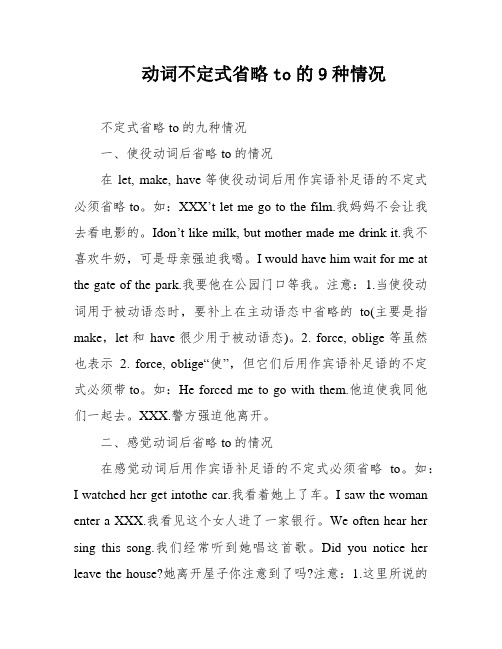
动词不定式省略to的9种情况不定式省略to的九种情况一、使役动词后省略to的情况在let, make, have等使役动词后用作宾语补足语的不定式必须省略to。
如:XXX’t let me go to the film.我妈妈不会让我去看电影的。
Idon’t like milk, but mother made me drink it.我不喜欢牛奶,可是母亲强迫我喝。
I would have him wait for me at the gate of the park.我要他在公园门口等我。
注意:1.当使役动词用于被动语态时,要补上在主动语态中省略的to(主要是指make,let和have很少用于被动语态)。
2. force, oblige等虽然也表示 2. force, oblige“使”,但它们后用作宾语补足语的不定式必须带to。
如:He forced me to go with them.他迫使我同他们一起去。
XXX.警方强迫他离开。
二、感觉动词后省略to的情况在感觉动词后用作宾语补足语的不定式必须省略to。
如:I watched her get intothe car.我看着她上了车。
I saw the woman enter a XXX.我看见这个女人进了一家银行。
We often hear her sing this song.我们经常听到她唱这首歌。
Did you notice her leave the house?她离开屋子你注意到了吗?注意:1.这里所说的感觉动词主要包括see, hear, observe, notice, feel, watch等。
但是它们用于被动语态时,其后的不定式必须带to。
如:XXX woman was XXX enter a XXX.有人看见这个女人进了一家银行。
但是,用于以上句型的动词notice和watch和通常不用于被动语态。
2.类似地,动词look at和listen to后用作宾语补足语的不定式也不带to。
探讨省略to的动词不定式的语法规则

探讨省略to的动词不定式的语法规则
动词不定式是英语中的一种常见语法结构,而to是将动词不定式和动作的执行者隔开的符号。
但是,在某些情况下可以省略to,那么何时可以省略,何时不可以省略呢?
可以省略to的情况
1.当动词不定式作为宾语时,to可以省略。
例如:I want (to) watch a movie tonight.(我今晚想看电影。
)
2.介词后面所跟的动词不定式中的to可以省略。
例如:He refused to talk to me. / He refused talking to me.(他拒绝和我谈话。
)
3.特定动词后面的动词不定式中的to可以省略。
例如:let me know / let me to know(让我知道)
不可以省略to的情况
1.当动词不定式作为主语或表语时,to不可省略。
例如:To be or not to be, that is the question.(生存还是毁灭,这是一个问题。
)
2.在被动语态中,to不可省略。
例如:The building is going to be demolished.(这座建筑将要被拆除。
)
3.在复合宾语结构中,to不可省略。
例如:I want you to help me.(我想让你帮我。
)
综上所述,省略to的动词不定式在特定情况下是可以的,但是也需要视情况而定,不能一味地省略。
掌握好省略to的动词不定式的语法规则,可以有效提高英语的表达水平。
动词不定式to的省略

动词不定式To 的几种常见的省略形式
3.常用的结构may well do,may as
well do (还是…好了)及but或except后 接不定式时,如果它们前面有do便可 省略to,其结构为can not do but…, can not help but…等句型。
动词不定式To 的几种常见的省略形式
e.g. We might as well put up here for tonight. She can’t do nothing but/except ask silly questions. She did nothing but complain.
动词不定式To 的几种常见的省略形式
4. 在had better,would rather,rather than
动词不定式To 的几种常见的省略形式
e.g. I’d like to stay with you, help you and learn from you. She told us to stay at home and wait till she came back.
动词不定式To 的几种常见的省略形式
动词不定式To 的几种常见的省略形式
e.g. He noticed Tom take a branch of flowers in his hand. The teacher has us write a composition every week. 注: 在变成被动语态时要加上to。 The person was seen to enter the shop by us.
之后省略to. e.g. You‘d better not tell him the news .
动词不定式中“to”的省略

动词不定式中“to”的省略动词不定式是由“to+动词原形”构成的。
在实际运用中,小品词to在某些场合会被省略,下面简要归纳一下这些特殊情况。
1.在某些表示感官的动词(组)如feel, listen to, hear, look at, see, watch, notice等的复合宾语中,动词不定式不带to。
例如:We often hear her sing this song.我们经常听到她唱这首歌。
I saw him play basketball.我见过他打篮球。
2.在使役动词make, let, have等的复合宾语中,动词不定式不带to。
例如:Now let me hear you play.现在让我听你演奏。
They made him work all day.他们让他整天工作。
注意:上述两类句子若是变为被动语态,则原来作宾语补足语的不定式须带to。
例如:She is often heard to sing this song.He was made to work all day.3.动词help的复合宾语中,动词不定式既可带to,也可不带to。
例如:Will you help me learn English?=Will you help me to learn English?4.help后面的动词不定式作宾语时也可省去to。
例如:Then he helped sweep the floor.那时他帮助扫地。
The new policy has helped raise his wages.新政策使他提高了工资。
5.当两个或两个以上不定式短语连用而且作用相同时,那么除第一个不定式短语用to 外,其余的不定式短语可省略to。
例如:This article is easy to read and understand.这篇文章浅显易懂。
He taught us to read and write.他教我们读书、写字。
动词不定式省略to的9种情况

不定式省略to的九种情况一、使役动词后省略to的情况在let,make,have等使役动词后用作宾语补足语的不定式必须省略to。
如:Mymotherwouldn’tletmegotothefilm.我妈妈不会让我去看电影的。
Idon’tlikemilk,butmothermademedrinkit.我不喜欢牛奶,可是母亲强迫我喝。
Iwouldhavehimwaitformeatthegateofthepark.我要他在公园门口等我。
注意:1.当使役动词用于被动语态时,要补上在主动语态中省略的to(主要是指make,let和have很少用于被动语态)。
2.force,oblige等虽然也表示2.force,oblige“使”,但它们后用作宾语补足语的不定式必须带to。
如:Heforcedmetogowiththem.他迫使我同他们一起去。
Thepolice obligedhimtoleave.警方强迫他离开。
二、感觉动词后省略to的情况在感觉动词后用作宾语补足语的不定式必须省略to。
如:Iwatchedhergetinto thecar.我看着她上了车。
Isawthewomanenterabank.我看见这个女人进了一家银行。
Weoftenhearhersingthissong.我们经常听到她唱这首歌。
Didyounoticeherleavethehouse?她离开屋子你注意到了吗?注意:1.这里所说的感觉动词主要包括see,hear,observe,notice,feel,watch等。
但是它们用于被动语态时,其后的不定式必须带to。
如:Thewomanwasseen toenterabank.有人看见这个女人进了一家银行。
但是,用于以上句型的动词notice和watch和通常不用于被动语态。
2.类似地,动词lookat和listento 后用作宾语补足语的不定式也不带to。
如:Welistenedtotheoldmantellhissto r y .我们听这位老人讲述3.若动词feel 后用作宾语补足语的不定 式为t o b e ,t o (其他情to)。
英语中不定式省略to的10种情况
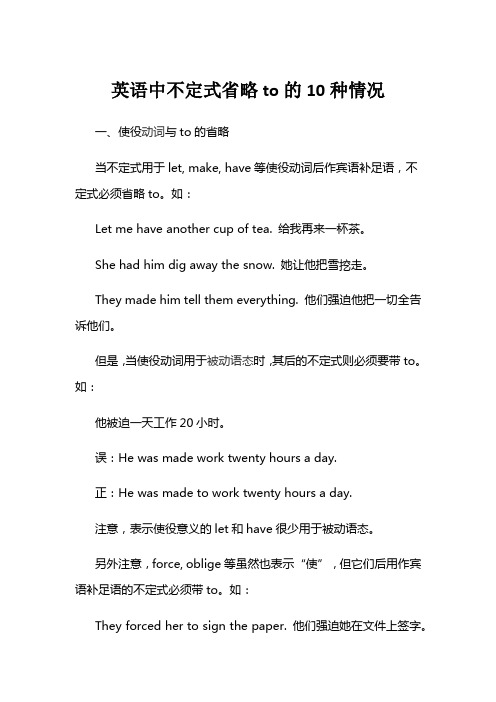
英语中不定式省略to的10种情况一、使役动词与to的省略当不定式用于let, make, have等使役动词后作宾语补足语,不定式必须省略to。
如:Let me have another cup of tea. 给我再来一杯茶。
She had him dig away the snow. 她让他把雪挖走。
They made him tell them everything. 他们强迫他把一切全告诉他们。
但是,当使役动词用于被动语态时,其后的不定式则必须要带to。
如:他被迫一天工作20小时。
误:He was made work twenty hours a day.正:He was made to work twenty hours a day.注意,表示使役意义的let和have很少用于被动语态。
另外注意,force, oblige等虽然也表示“使”,但它们后用作宾语补足语的不定式必须带to。
如:They forced her to sign the paper. 他们强迫她在文件上签字。
The law obliged parents to send their children to school. 法律要求父母送子女上学。
二、感觉动词与to的省略当不定式用于表示感觉的动词feel, hear, notice, observe, see, watch, look at, listen to等作宾语补足语时,不定式必须省略to。
如:We all felt the house shake. 我们都感觉这房子在震动。
I heard him go down the stairs. 我听见他下楼了。
Did you notice her leave the house? 她离开屋子你注意到了吗?I watched her get into the car. 我看着她上了车。
但是,当feel后用作宾语补足语的不定式为to be时,则不能省略to。
不定式省略to的10种情况

不定式省略to的几种情况一、使役动词与to的省略当不定式用于let, make, have等使役动词后作宾语补足语,不定式必须省略to。
如:Let me have another cup of tea.给我再来一杯茶。
She had him dig away the snow.她让他把雪挖走。
They made him tell them everything.他们强迫他把一切全告诉他们。
但是,当使役动词用于被动语态时,其后的不定式则必须要带to。
如:他被迫一天工作20小时。
误:He was made work twenty hours a day.正:He was made to work twenty hours a day.注意,表示使役意义的let和have很少用于被动语态。
另外注意,force, oblige等虽然也表示“使”,但它们后用作宾语补足语的不定式必须带to。
如:They forced her to sign the paper.他们强迫她在文件上签字。
The law obliged parents to send their children to school.法律要求父母送子女上学。
二、感觉动词与to的省略当不定式用于表示感觉的动词feel, hear, notice, observe, see, watch, look at, listen to等作宾语补足语时,不定式必须省略to。
如:We all felt the house shake.我们都感觉这房子在震动。
I heard him go down the stairs.我听见他下楼了。
Did you notice her leave the house?她离开屋子你注意到了吗?I watched her get into the car.我看着她上了车。
但是,当feel后用作宾语补足语的不定式为to be时,则不能省略to。
省略to的动词不定式

"大家都知道在动词不定式to do中,“to”是不定式的标志,有了这个to,后面所跟的动词该用原形。
但是to也有可以省略的时候,这个时候虽然没有了to,后面所跟的动词依然用原形。
今天的每日一课就给大家总结一些省略to的动词不定式。
1、情态动词(除ought 外)后的to已省略。
例:You must go to the hospital first. 你必须先去医院。
I can swim well. 我能游得很好。
2、使役动词let, have, make后,感官动词see, watch, look at, notice , observe, hear, listen to, smell, feel, find 等词后的to省略。
例:He made the baby crying all night long. 他让那个婴儿哭了一整夜。
Let it be. 就这样吧。
when I passed by, I saw the girl picking the flowers. 我经过的时候,看见那个女孩在摘花。
注意:在这些词的用法中,用于被动语态时不能省去to。
例:I saw him dance. 我看见他跳舞。
=He was seen to dance.The boss made them work the whole night. 老板让他们整夜干活。
=They were made to work the whole night.3、would rather/had better 后的to省略。
例:I would rather go to Japan than the USA.我宁愿去日本也不想去美国。
You had better take a hat with you.你最好带上一顶帽子。
4、why…/why not…句型中not后to省略。
例:why not come to my home for a dinner tonight?今晚何不来我家吃顿饭。
归纳省略to的动词不定式用法
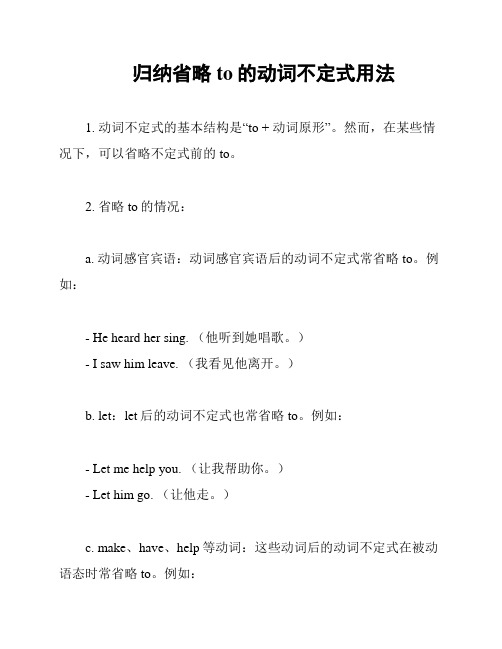
归纳省略to的动词不定式用法1. 动词不定式的基本结构是“to + 动词原形”。
然而,在某些情况下,可以省略不定式前的to。
2. 省略to的情况:a. 动词感官宾语:动词感官宾语后的动词不定式常省略to。
例如:- He heard her sing. (他听到她唱歌。
)- I saw him leave. (我看见他离开。
)b. let:let后的动词不定式也常省略to。
例如:- Let me help you. (让我帮助你。
)- Let him go. (让他走。
)c. make、have、help等动词:这些动词后的动词不定式在被动语态时常省略to。
例如:- She made me clean the room. (她让我打扫房间。
)- I had him fix the car. (我让他修理汽车。
)- He helped her find a job. (他帮她找到了工作。
)d. 情态动词:情态动词后的动词不定式常省略to。
例如:- You should study hard. (你应该努力研究。
)- He can't swim. (他不会游泳。
)3. 注意事项:- 当动词不定式作为名词、形容词或副词的补语时,不省略to。
例如:- My dream is to travel around the world. (我的梦想是周游世界。
)- She is happy to see you. (她高兴地看到了你。
)- He came to help us. (他来了帮助我们。
)- 不定式前如果有形容词或副词修饰,to不能省略。
例如:- She is too tired to dance. (她太累了,无法跳舞。
)- I was too scared to speak. (我害怕得说不出话。
)以上是关于省略to的动词不定式用法的归纳总结。
希望对您有所帮助。
动词不定式符号to的省略
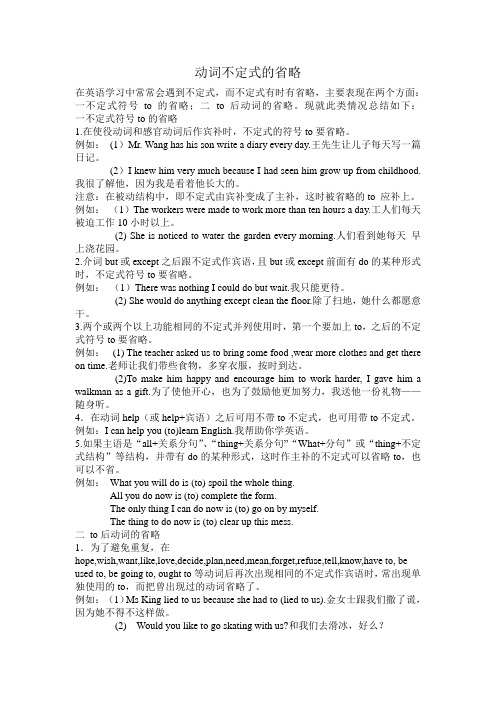
动词不定式的省略在英语学习中常常会遇到不定式,而不定式有时有省略,主要表现在两个方面:一不定式符号to的省略;二to后动词的省略。
现就此类情况总结如下:一不定式符号to的省略1.在使役动词和感官动词后作宾补时,不定式的符号to要省略。
例如:(1)Mr. Wang has his son write a diary every day.王先生让儿子每天写一篇日记。
(2)I knew him very much because I had seen him grow up from childhood.我很了解他,因为我是看着他长大的。
注意:在被动结构中,即不定式由宾补变成了主补,这时被省略的to 应补上。
例如:(1)The workers were made to work more than ten hours a day.工人们每天被迫工作10小时以上。
(2) She is noticed to water the garden every morning.人们看到她每天早上浇花园。
2.介词but或except之后跟不定式作宾语,且but或except前面有do的某种形式时,不定式符号to要省略。
例如:(1)There was nothing I could do but wait.我只能更待。
(2) She would do anything except clean the floor.除了扫地,她什么都愿意干。
3.两个或两个以上功能相同的不定式并列使用时,第一个要加上to,之后的不定式符号to要省略。
例如:(1) The teacher asked us to bring some food ,wear more clothes and get there on time.老师让我们带些食物,多穿衣服,按时到达。
(2)To make him happy and encourage him to work harder, I gave him a walkman as a gift.为了使他开心,也为了鼓励他更加努力,我送他一份礼物——随身听。
浅谈动词不定式to的省略现象
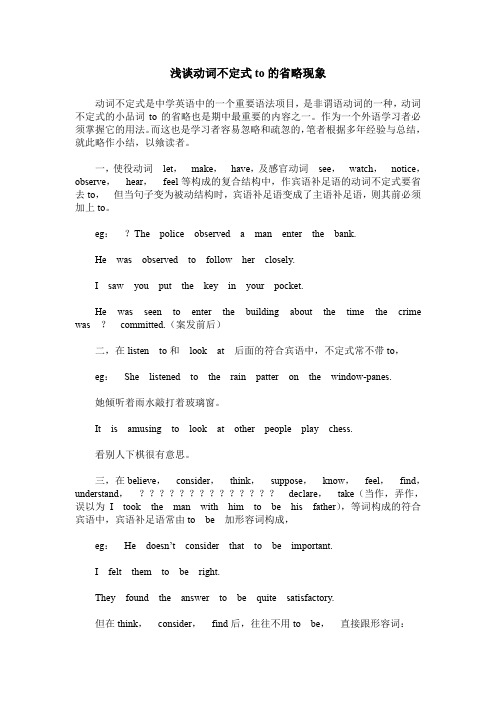
浅谈动词不定式to的省略现象动词不定式是中学英语中的一个重要语法项目,是非谓语动词的一种,动词不定式的小品词to的省略也是期中最重要的内容之一。
作为一个外语学习者必须掌握它的用法。
而这也是学习者容易忽略和疏忽的,笔者根据多年经验与总结,就此略作小结,以飨读者。
一,使役动词let,make,have,及感官动词see,watch,notice,observe,hear,feel等构成的复合结构中,作宾语补足语的动词不定式要省去to,但当句子变为被动结构时,宾语补足语变成了主语补足语,则其前必须加上to。
eg:?The police observed a man enter the bank.He was observed to follow her closely.I saw you put the key in your pocket.He was seen to enter the building about the time the crime was?committed.(案发前后)二,在listen to和look at后面的符合宾语中,不定式常不带to,eg:She listened to the rain patter on the window-panes.她倾听着雨水敲打着玻璃窗。
It is amusing to look at other people play chess.看别人下棋很有意思。
三,在believe,consider,think,suppose,know,feel,find,understand,??????????????declare,take(当作,弄作,误以为I took the man with him to be his father),等词构成的符合宾语中,宾语补足语常由to be加形容词构成,eg:He doesn’t consider that to be important.I felt them to be right.They found the answer to be quite satisfactory.但在think,consider,find后,往往不用to be,直接跟形容词:They found her(to be)charming.(很招人喜欢)Who do you consider(to be)responsible for the accident?四,连词but(除……之外),前若有动词do及其它do的形式(does,did,done,doing)时,其后的动词不定式不带to.反之,如果是其他动词,则要带to。
关于动词不定式中省略to的几种情况
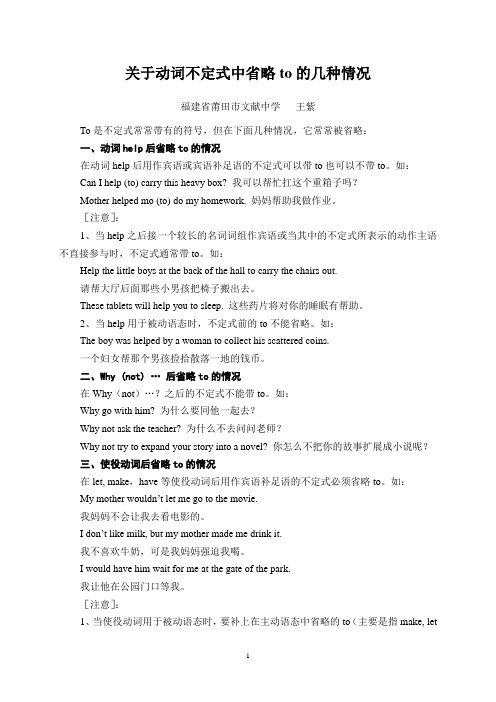
关于动词不定式中省略to的几种情况福建省莆田市文献中学王紫To是不定式常常带有的符号,但在下面几种情况,它常常被省略:一、动词help后省略to的情况在动词help后用作宾语或宾语补足语的不定式可以带to也可以不带to。
如:Can I help (to) carry this heavy box? 我可以帮忙扛这个重箱子吗?Mother helped mo (to) do my homework. 妈妈帮助我做作业。
[注意]:1、当help之后接一个较长的名词词组作宾语或当其中的不定式所表示的动作主语不直接参与时,不定式通常带to。
如:Help the little boys at the back of the hall to carry the chairs out.请帮大厅后面那些小男孩把椅子搬出去。
These tablets will help you to sleep. 这些药片将对你的睡眠有帮助。
2、当help用于被动语态时,不定式前的to不能省略。
如:The boy was helped by a woman to collect his scattered coins.一个妇女帮那个男孩捡拾散落一地的钱币。
二、Why (not) …后省略to的情况在Why(not)…?之后的不定式不能带to。
如:Why go with him? 为什么要同他一起去?Why not ask the teacher? 为什么不去问问老师?Why not try to expand your story into a novel? 你怎么不把你的故事扩展成小说呢?三、使役动词后省略to的情况在let, make,have等使役动词后用作宾语补足语的不定式必须省略to。
如:My mother wouldn’t let me go to the movie.我妈妈不会让我去看电影的。
I don’t like milk, but my mother made me drink it.我不喜欢牛奶,可是我妈妈强迫我喝。
动词不定式省略to的情形

Practice况 1.主语部分有to do ,系动词 is/was 时,作表语的不定式通常省去to。 如: The only thing you have to do is _____ press (press) the button. 2. 作介词but, expect, besides 的宾语, 前面又有实意动词 do时,不定 式通常省去to. 如:W had nothing to do but _____ (wait). wait 比较:We had no option but _____ (wait) . to wait 3. 主语部分暗含to do, 表语中的不定式通常省去to。如: All I want (to do) is _____ (go) to school and study hard . go 4.当两个或多个不定式并列时,其后的不定式符号可以省略, 如: I want to take a bath and _____ (go) to bed at once. go 但有对比关系时不可省略: It is easier to say than _____ (do) . to do
5.在would rather…than… 等结构中,不定式符号常常要省略. 如: I would rather stay at home than _____ go (go) to see a film. I prefer to stay at home rather than _____ (go) to see a film. go 比较 : I watched TV rather than did ___ (do) my homework last night . I like singing rather than _______ dancing (dance) . 6. 在see ,watch ,noti to ,look at ,feel ,have, make, let ,observe 等词 后作宾语补足语时省略不定式符号to; I heard her sing this song. 比较:I heard her singing the song. 变被动: She was heard _________________. to sing this song She was heard ________________. singing this song 7. why (not) do 结构 中, 不定式不带to Why not _____(join) us ?= Why don't ___________? you join us join
英语中动词不定式省略to的情况
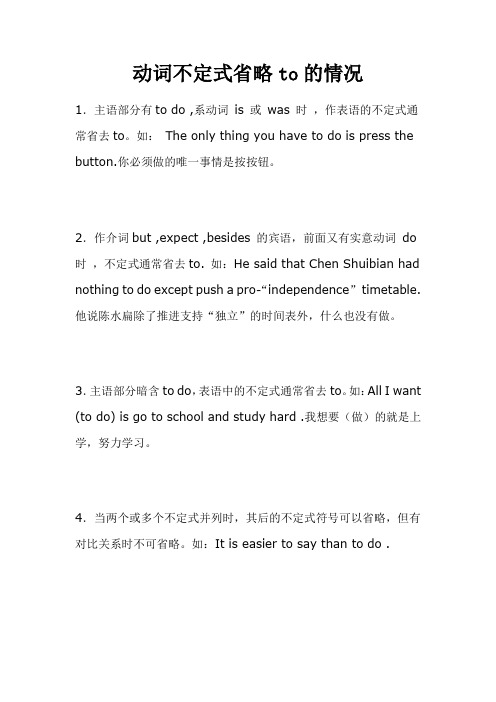
动词不定式省略to的情况1.主语部分有to do ,系动词is 或was 时,作表语的不定式通常省去to。
如:The only thing you have to do is press the button.你必须做的唯一事情是按按钮。
2.作介词but ,expect ,besides 的宾语,前面又有实意动词do 时,不定式通常省去to. 如:He said that Chen Shuibian had nothing to do except push a pro-“independence”timetable.他说陈水扁除了推进支持“独立”的时间表外,什么也没有做。
3.主语部分暗含to do,表语中的不定式通常省去to。
如:All I want (to do) is go to school and study hard .我想要(做)的就是上学,努力学习。
4.当两个或多个不定式并列时,其后的不定式符号可以省略,但有对比关系时不可省略。
如:It is easier to say than to do .5.在would rather…than…等结构中,不定式符号常常要省略. 如:I would rather stay at home than go to see a film.我宁愿呆在家也不愿去看电影。
6.在see ,watch ,notice ,hear, listen to ,look at ,feel ,have, make, let ,observe 等词后作宾语补足语时省略不定式符号to;why (not) do 结构中, 不定式不带to.(1) I saw her enter the room . 我看见她进入了房间(2) Why not join us ?为什么不加入到我们的行列里来呢?。
英语中不定式省略to的九种情况
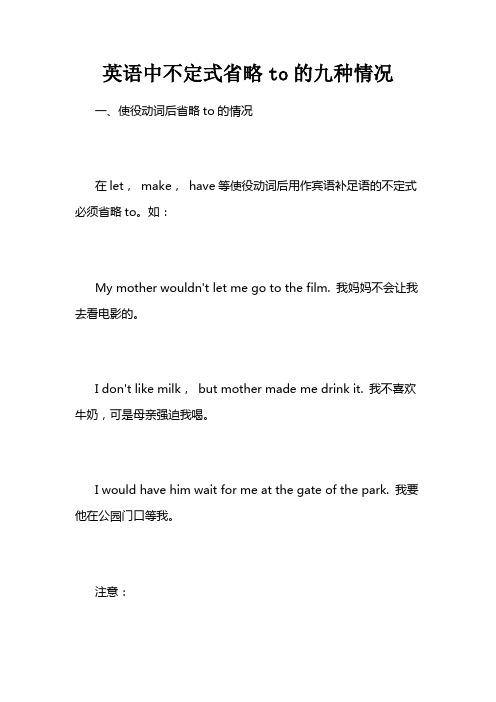
英语中不定式省略to的九种情况一、使役动词后省略to的情况在let,make,have等使役动词后用作宾语补足语的不定式必须省略to。
如:My mother wouldn't let me go to the film. 我妈妈不会让我去看电影的。
I don't like milk,but mother made me drink it. 我不喜欢牛奶,可是母亲强迫我喝。
I would have him wait for me at the gate of the park. 我要他在公园门口等我。
注意:1. 当使役动词用于被动语态时,要补上在主动语态中省略的to(主要是指make,let和have很少用于被动语态)。
2. force,oblige等虽然也表示“使”,但它们后用作宾语补足语的不定式必须带to。
如:He forced me to go with them. 他迫使我同他们一起去。
The police obliged him to leave. 警方强迫他离开。
二、感觉动词后省略to的情况在感觉动词后用作宾语补足语的不定式必须省略to。
如:I watched her get into the car. 我看着她上了车。
I saw the woman enter a bank. 我看见这个女人进了一家银行。
We often hear her sing this song. 我们经常听到她唱这首歌。
Did you notice her leave the house?她离开屋子你注意到了吗?注意:1. 这里所说的感觉动词主要包括see,hear,observe,notice,feel,watch等。
但是它们用于被动语态时,其后的不定式必须带to。
如:The woman was seen to enter a bank. 有人看见这个女人进了一家银行。
但是,用于以上句型的动词notice 和watch通常不用于被动语态。
不定式省略to的几种情况及练习题
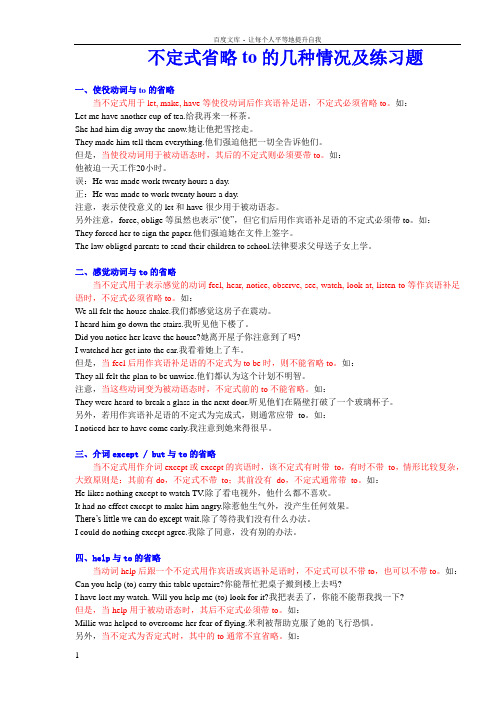
不定式省略to的几种情况及练习题一、使役动词与to的省略当不定式用于let, make, have等使役动词后作宾语补足语,不定式必须省略to。
如:Let me have another cup of tea.给我再来一杯茶。
She had him dig away the snow.她让他把雪挖走。
They made him tell them everything.他们强迫他把一切全告诉他们。
但是,当使役动词用于被动语态时,其后的不定式则必须要带to。
如:他被迫一天工作20小时。
误:He was made work twenty hours a day.正:He was made to work twenty hours a day.注意,表示使役意义的let和have很少用于被动语态。
另外注意,force, oblige等虽然也表示“使”,但它们后用作宾语补足语的不定式必须带to。
如:They forced her to sign the paper.他们强迫她在文件上签字。
The law obliged parents to send their children to school.法律要求父母送子女上学。
二、感觉动词与to的省略当不定式用于表示感觉的动词feel, hear, notice, observe, see, watch, look at, listen to等作宾语补足语时,不定式必须省略to。
如:We all felt the house shake.我们都感觉这房子在震动。
I heard him go down the stairs.我听见他下楼了。
Did you notice her leave the house?她离开屋子你注意到了吗?I watched her get into the car.我看着她上了车。
但是,当feel后用作宾语补足语的不定式为to be时,则不能省略to。
省略to的不定式了解省略to的不定式的用法

省略to的不定式了解省略to的不定式的用法不定式是英语中的一种非谓语动词形式,它通常由动词原形加上to 构成,例如:to go(去), to eat(吃),to sleep(睡觉)等。
然而,在某些情况下,我们可以忽略不定式前的to,这种形式被称为省略to的不定式。
本文将介绍省略to的不定式的用法以及相关注意事项。
一、省略to的不定式主要用于下列几种情况:1. 动词let当动词let后面接不定式时,to可以省略。
例如:- She let me go to the party.(她让我去参加派对。
)2. 感官动词感官动词如see、watch、hear等后面接宾语和不定式时,to可以省略。
例如:- I heard him sing in the concert.(我听到他在音乐会上唱歌。
)3. 情态动词情态动词如can、may、must等后面接不定式时,to可以省略。
例如:- You must do your homework before playing games.(你必须先做作业再玩游戏。
)4. 动词help当动词help后面接不定式时,to可以省略。
例如:- He helped me carry the heavy boxes.(他帮我搬运沉重的箱子。
)二、需要注意的细节问题:1. 第一个动词是make、let、help、see、hear、watch或feel时,后面的动词不定式可以省略to;2. 在句子中,第一个动词是感官动词或情态动词时,后面的动词不定式可以省略to;3. 省略to的不定式只适用于动词不定式的主动形式,不能用于被动形式;4. 不定式的完整形式“to + 动词原形”通常更正式,所以在正式场合或文学作品中,建议使用完整形式。
三、案例分析:1. They helped me (to) clean the house before the guests arrived.(他们帮我在客人到来之前打扫了房间。
不定式省略to的几种情况及练习题

不定式省略to的几种情况及练习题一、使役动词与to的省略当不定式用于let, make, have等使役动词后作宾语补足语,不定式必须省略to。
如:Let me have another cup of tea.给我再来一杯茶。
She had him dig away the snow.她让他把雪挖走。
They made him tell them everything.他们强迫他把一切全告诉他们。
但是,当使役动词用于被动语态时,其后的不定式则必须要带to。
如:他被迫一天工作20小时。
误:He was made work twenty hours a day.正:He was made to work twenty hours a day.注意,表示使役意义的let和have很少用于被动语态。
另外注意,force, oblige等虽然也表示“使”,但它们后用作宾语补足语的不定式必须带to。
如:They forced her to sign the paper.他们强迫她在文件上签字。
The law obliged parents to send their children to school.法律要求父母送子女上学。
二、感觉动词与to的省略当不定式用于表示感觉的动词feel, hear, notice, observe, see, watch, look at, listen to等作宾语补足语时,不定式必须省略to。
如:We all felt the house shake.我们都感觉这房子在震动。
I heard him go down the stairs.我听见他下楼了。
Did you notice her leave the house?她离开屋子你注意到了吗?I watched her get into the car.我看着她上了车。
但是,当feel后用作宾语补足语的不定式为to be时,则不能省略to。
省略to的不定式

不定式否定式的几点用法注意
1、不定式的否定式的构成 不定式的否定式通常是将否定词not或never置于不定式之前,即构成not to do 或never to do 这样的形式。 注意not和never一定要放在不定式符号to的前面,而不是其后面。如: He told me not to open the door. 他让我别开门。 Take care not to break the glass. 小心别把玻璃杯打碎了。
I told him not to make a mess in the kitchen. 我叫他不要把厨房弄得乱七八槽。
I promise never to smoke again. 我保证再也不抽烟了。
I’ll let you off if you promise never to do it again. 如果你答应以后再不这样做我可以放过你
二· 、不定式否定式几点值得注意之处 1. 完成式的否定式:如果不定式为完成式,否定词应放在to have之前。如:
She pretended not to have seen him. 她假装没看见他。
You were silly not to have locked your car. 你真笨,竟然没有把汽车锁好。 2. 被动式的否定式:如果不定式为被动式,否定词应放在to be之前。如:
3)在“do nothing but(or.except)..., there be sth.to do but(or except)... , sb.have sth.to do but”等结构中, 介词,but(or except)后用不带to的动词不定形式。 如: He did nothing at the meeting but smoke. 他在会上什么也没干只是吸烟。 I have nothing to do except copy the article for him. 我只好给他抄写这篇文章。
动词不定式省略的几种情况

动词不定式省略的⼏种情况动词不定式的基本形式是“to + 动词原形”。
但有些词后⾯的“to”有时会省略。
归纳起来,常有下列⼏种情况:1. 作使役动词(如make,let,have)和感官动词(如look at,see,hear,watch,listen to,notice)等的宾语补⾜语时。
如:They made the children work 12 hours a day. 他们强迫孩⼦们⼀天⼲12⼩时。
Let me go. 让我去吧。
I saw him come. 我看见他来了。
We often hear her sing an English song in the classroom. 我们经常听见她在教室唱英语歌。
值得注意的是:以上句⼦若变为被动语态时,“to”则不能省略。
2. 在动词help后的动词不定式可带“to”,也可不带“to”。
如:Will you help me (to) plant this tree,please?请你帮我种这棵树,好吗?3. 两个或两个以上不定式连⽤,其作⽤相同时,除第⼀个不定式带“to”外,其余不带“to”。
如:It’s better to give than receive. 给予⽐索取好。
4. 在Why not后。
如:Why not have some milk? 为什么不来些⽜奶呢?5. had better /best,would rather等固定结构中。
如:I would rather stay here. 我宁可留在这⼉。
6. 在but,except,besides介词前⾯有⼀定义动词“do”时,介词后的不定式可以省略“to”。
如:We can do nothing but wait. 除了等我们别⽆他法。
7. 在助动词和情态动词后接动词原形,动词也是不带“to”的动词不定式的⼀种形式。
如:We can’t play basketball until we finish our homework. 直到完成作业后我们才能去打篮球。
- 1、下载文档前请自行甄别文档内容的完整性,平台不提供额外的编辑、内容补充、找答案等附加服务。
- 2、"仅部分预览"的文档,不可在线预览部分如存在完整性等问题,可反馈申请退款(可完整预览的文档不适用该条件!)。
- 3、如文档侵犯您的权益,请联系客服反馈,我们会尽快为您处理(人工客服工作时间:9:00-18:30)。
动词不定式To 的几种常见的省略形式
7. 在一定的上下文中,为了避免重复, 有时不定式可以省略,但通常保留不 定式符号to。 e.g. I shall go if I want to. “Don’t be late.” “I’ll try not to.” Don’t go till I tell you to.
动词不定式To 的几种常见的省略形式
D live in the country than in 3. He ______ the city. A prefers B likes to C had better D would rather 4. The boy told his father that he would rather ______ an astronaut. A A become B to become C becoming D became
动词不定式To 的几种常见的省略形式
注:如果两个不定式表示对照或对比时, 则不能省略to. e.g. To try and fail is better than not to try at all. He hasn’t decided whether to quit or to stay. To be or not to be, that is a question.
动词不定式To 的几种常见的省略形式
2. 由 all, what 引导的主语从句或者主语 被only, first, one, least 或形容词最高级 修饰时,而且从句中含有do时,其表语 如果是动词不定式,则往往省去to。
动词不定式To 的几种常见的省略形式
e.g. All I did was empty the bottle.
动词不定式To 的几种常见的省略形式
e.g. We might as well put up here for tonight.
She can’t do nothing but/except ask silly questions. She did nothing but complain.
ห้องสมุดไป่ตู้
动词不定式To 的几种常见的省略形式
What I wanted to do was drive all night.
The only thing I could do was do it myself.
动词不定式To 的几种常见的省略形式
3.常用的结构may well do,may as well do (还是…好了)及but或except后 接不定式时,如果它们前面有do便可 省略to,其结构为can not do but…, can not help but…等句型。
5. 以Why或Why not 开头表请求的结构 中常跟上动词原形,省略to。
e.g. Why go with him?
Why not go out for a walk ? You look tired. Why not have a good rest.
动词不定式To 的几种常见的省略形式
6.由并列连词and,than, or 连接两个以 第二个动词不定式不带to。。 .
动词不定式To 的几种常见的省略形式
B out. 7. He wants to do nothing but __ A to go B go C going Dgoes A 8. He wants to believe anything but___ the medicine. A to take B took C take D takes
上的具有相同意义或功能的不定式时,
动词不定式To 的几种常见的省略形式
e.g. I’d like to stay with you, help you and learn from you. She told us to stay at home and wait till she came back.
动词不定式To 的几种常见的省略形式
e.g. He noticed Tom take a branch of flowers in his hand. The teacher has us write a composition every week. 注: 在变成被动语态时要加上to。 The person was seen to enter the shop by us.
动词不定式To 的几种常见的省略形式
9. Compared with women, men always prefer ____ B at home rather than ____ so much time shopping . A to finish ,to spend B to finish ,spend C finish ,spend D finish ,to spend
动词不定式To 的 几种常见的省略形式
动词不定式To 的几种常见的省略形式
1. 感官动词和使役动词在主动语态中 不需要带to,即我们常说的“一觉二 听三让五看”:feel, listen to , hear , let, make, have, see, watch, notice, observe, look at.
动词不定式To 的几种常见的省略形式
5. Paul doesn't have to be made ___. B He always works hard. A. learn B. to learn C. learned D. learning 6. --- I usually go there by train. D by boat for a change? ---- Why not ___ A. to try going B. trying to go C. to try and go D. try going
动词不定式To 的几种常见的省略形式
1.You had better ______ B your hair cut. A. had B. have C to get D to have D put the meeting off for a 2. We ______ week. A can as well B. will as well C. shall as well D . may as well
4. 在had better,would rather,rather than 之后省略to. e.g. You‘d better not tell him the news . Rather than wait anyone, I decided to go home by taxi.
动词不定式To 的几种常见的省略形式
